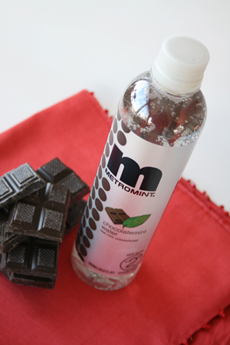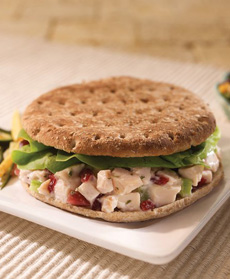TIP OF THE DAY: Better Eating In 2014
|
How’s that New Year’s resolution to eat healthier going so far? Need some inspiration?
Here are some tips from two prominent nutritionists. Whether you want to lose weight, eat more nutritious foods or both, if you follow even one of them, you’re heading in a positive direction. Nutritionist Keri Glassman of NutritiousLife.com shared these tips with us: 1. Set goals for yourself. In order to stay motivated beyond mid-January and make it through the year, set goals that are both attainable and reasonable. Instead of strictly avoiding certain foods (you can have a piece of pizza, but not two and not every day), focus on what you should eat to help increase your overall health and meet your goals. Goals can be quite modest, such as incorporating a vegetable or salad into your dinner each day. Don’t be daunted by what you think you can’t do: Master everything in baby steps. |
|
|
|
2. Incorporate a superfood into every meal. Superfoods are those that go beyond basic nutrition and offer “super” health benefits. They include almonds, apples, beans, blueberries, oranges, pumpkin, salmon, spinach and walnuts. Web MD adds broccoli, oats, probiotic yogurt, soy, tea (black, green or white), tomatoes and turkey to the list. Try adding blueberries to your morning oatmeal, having a hearty black bean soup with a yogurt garnish for lunch, and salmon with broccoli and a baked sweet potato for dinner. 3. Eat More Whole Grains. Whole grains are a key component of healthy eating. They’re a great source of fiber, as well as essential vitamins and minerals. Fiber promotes satiety and keeps you feeling full longer, which helps to avoid snacking throughout the day. Whole grains also lower your risk of cardiovascular disease, type 2 diabetes and certain cancers. (If you’re young enough that this seems remote, remember that everything you do throughout your life adds up in the end.) Simply switch your white bread, white rice and conventional pasta for whole grain bread and pasta, and brown rice or other whole grain. Other delicious whole grains include barley, brown rice, oats, popcorn and quinoa. In fact, there are more than 20 whole grains from which to choose. Check put this list of whole grain foods. |
||
 If you like chocolate and mint, this calorie-free flavored water is a-maz-ing! Photo by Hannah Kaminsky | THE NIBBLE. |
4. Stash Healthy Snacks. It is far too easy to make poor food decisions when you’re on the go, when empty calories beckon from every corner. So keep your briefcase, car, gym bag, purse, tote, etc. stocked with nutritious and filling snacks: nuts (almonds, cashews, pecans, and/or walnuts measured into one-ounce portions), dried fruit, fresh fruit (apples and bananas are the least messy) and individual packets of popcorn. If you like crackers, take a look at high fiber crackers like Wasa Whole Grain Crispbread, with 12 g of fiber per serving. You can pair them with a slice of turkey or some peanut butter. If you’re a PB fan, carry individual squeeze packets from Peanut Butter & Co (in regular or chocolate PB); or Barney Butter almond butter. Jif and Skippy have individual portion cups. 5. Fill Up On Water and Tea. Drinking enough water is one of the most important things you can do every day. Not only does it play an important role in many body processes, such as flushing out toxins and delivering key nutrients to cells; it also helps you to avoid overeating. Herbal tea (no caffeine) counts toward your daily water intake. You won’t mistake hunger for thirst if you are properly hydrated. If plain water bores you, try flavored varieties (unsugared and zero calories, like Ayala, Hint and Metromint (the chocolate mint is amazing); or flavored, unsweetened seltzer. Add lemon or lime slices to plain water or seltzer. Make your own flavored water by keeping a pitcher of water in the fridge with fruits in it: Citrus, kiwi and strawberries infuse delightfully. |
|
|
Here are tips from Guiding Stars nutritionist Allison Stowell: 6. Become a mindful eater. Most of us cannot recall what we ate, or how much of fit, at the end of the day, much less yesterday. Whether you use a small notebook or a tracking app on your phone, be aware of what you’re eating. Then, you can make conscious decisions each time you make a food choice. The big bonus, according to Allison, is that this activity is very likely to lead to weight loss. 7. Read the nutrition labels. They can be eye opening. 8. Follow the rainbow. Color counts when it comes to eating well. Increase the colors on your plate and you’ll eat more fruits and vegetables. Start with at least one color per meal (beets, berries, green vegetables, tomatoes, etc.); then increase to two or more. 9. Cook. Yes, cook. It may sound simple but many of us don’t do it as often as we should. This leads to less-than-ideal choices in take-out, prepared foods and restaurant meals (which are also laden with extra salt and hidden sugar). Spending more time in the kitchen will improve your food choices: The more you cook, the more control you have. 10. Plan ahead. Fill your pantry and freezer with nutritious choices, such as frozen vegetables, brown rice, fish fillets and chicken breasts. Then, even when you don’t have time to shop, there will be something to eat at home. NIBBLE TIP: Salad fixings can go bad quickly, but bags of shredded broccoli slaw or cabbage slaw last three or four times as long and make tasty salads. THE “E” WORD Exercise: Either get to the gym at least 4 times a week, or factor other daily exercise into your regime. It doesn’t have to be time-consuming: 15 minutes daily of walking up two flights of steps instead of taking the elevator is better than an hour at the gym once a week.
|
||



